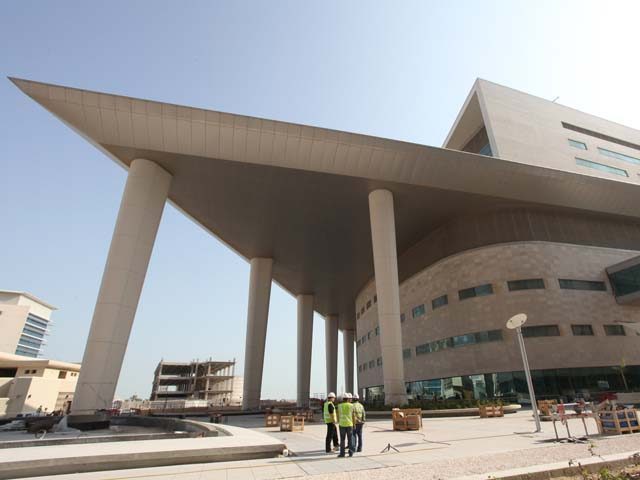
Hamad Medical Corp. (HMC) has announced new opening dates for seven upcoming hospitals in Qatar, many of which have already missed their initial deadlines.
By the end of December 2017, there will be more than 1,100 newly-built hospital beds for residents in the new facilities across Qatar, HMC said.
The projects include a women’s wellness center, a communicable diseases facility and three hospitals for workers.
The expansion is part of a wider plan to boost state healthcare services, which have increasingly come under strain as the population rises.
In a statement, Hamad Al Khalifa, HMC’s Chief of Healthcare Facilities, said:
“These new hospitals and facilities will revolutionize healthcare delivery in Qatar by increasing bed capacity and giving our patients faster access to specialized care where and when they need it.”
He added that once the projects come online, hospitals that are currently in operation should see more capacity.
All of the upcoming projects were originally due to open last year, but missed their launch dates.
In its statement, HMC did not give a reason for the delays and has also not detailed exactly when in 2016 or 2017 each facility will open.
New facilities
Among the new projects are three new facilities at Hamad Bin Khalifa Medical City, a QR2.4 billion medical complex on a 227,000 square meter site in Rumaila in central Doha:
- A Women’s Wellness and Research Center;
- An Ambulatory Care Center; and
- The Qatar Rehabilitation Institute.
Hamad Medical City is an Ashghal project led by Korean-based Hyundai Engineering and Construction Company, and was originally scheduled to be completed by 2014.
In January 2015, Qatar’s prime minister called for the first stage of the complex to be opened to the public by June last year, but that deadline was also missed.
The Women’s Wellness and Research Center – a 260-bed hospital with a capacity for 15,000 births a year – is slated to be among the first hospitals to open inside the complex.
It will have 53 neonatal intensive care cots and 48 “stepdown” cots for infants requiring intermediate care.

HMC previously told Doha News that the new center would replace the existing Women’s Hospital, which currently delivers around 17,000 babies a year.
The new wellness center is expected to make up for the lost capacity by working in conjunction with Sidra Medical and Research Center and other hospitals around Qatar.
While the first clinics in Sidra’s outpatient department opened this week, women cannot yet give birth there and there is no public date for the launch of the main hospital.
Meanwhile, the new Ambulatory Care Center, which HMC said is the first such specialist center in the region, will provide outpatient care and adult day-surgery for a range of elective procedures.
These will be for patients who do not need to stay overnight, but who may need anesthesia, a period of post-procedure observation or both, the healthcare authority said.
Its facilities will include 130 short-stay beds, a suite for radiology, examination, and treatment rooms, in addition to 14 operating theaters, according to previously-issued details for the center.
And the Qatar Rehabilitation Institute, which will have 193 beds over 10 floors on the 38,000 sq meter facility, will provide “comprehensive and integrated rehabilitation services for adults and children.”

The center will offer specialized services, including physiotherapy, occupational and speech therapy, prosthetics and orthotics.
There will also be a dedicated focus on stroke and traumatic brain injury treatments, and the hospital will have a hydrotherapy facility, according to HMC’s website.
Adjacent to the medical city will be a Communicable Diseases Center, which has 65 beds and is for the care, treatment, prevention and research of infectious and transmittable diseases such as tuberculosis, flu, MERS and measles.

Finally, three hospitals are expected to open in Doha’s Industrial Area, Al Khor and Mesiaeed to care for Qatar’s male, labor workforce.
The facilities were due to open in 2015, according to the then-Supreme Council of Health’s 2012 Annual Report.
However, by the end of that year the SCH’s director of public health, Sheikh Mohammed bin Hamad Al Thani, said it would likely be “during 2016, or the beginning of 2017” before they launched.
Increasing capacity
The launch of the new workers’ hospitals should help to ease the strain felt particularly by Hamad General Hospital’s emergency department, which is where many blue-collar expats seek treatment.
In 2014, HMC Emergency Department director Dr. Peter Cameron told members of Qatar’s Central Municipal Council that many low-paid expats used the ER for minor injuries or to receive treatment for chronic conditions such as hypertension or diabetes.
He called for more clinics and GP-type surgeries to be constructed to help take the pressure off of the emergency department.
Last year, HMC launched a 15-year masterplan that said it would double the number of hospital beds and operating theaters in the country and triple car parking provisions by 2030.
In addition to building and expanding new facilities in central Doha, the plan also includes increasing the capacity of Al Khor and Al Wakrah hospitals to 500 beds each by 2030.
Thoughts?







